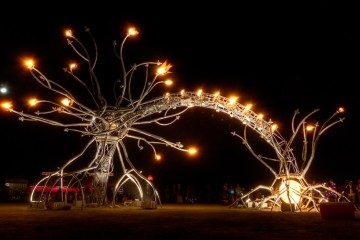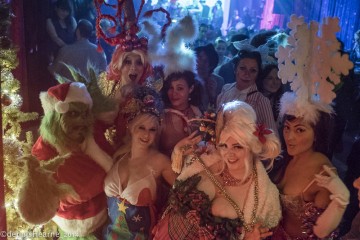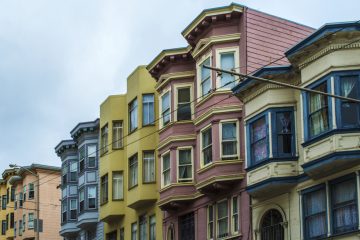Renegade Art Critic, SFAI Professor & Local Legend Mark Van Proyen
We here at BrokeAssStuart.com like to show love to the people who make cities like San Francisco and New York special. That’s why we’re doing a series called Local Legend of the Week. This is our chance to hip you to some of the strange, brilliant, and unique folks who populate these towns and give them the character that people from around the world have come to love.
Mark Van Proyen is a tenured professor, novelist and internationally recognized art critic. I caught up with him after his trip to Gwangju South Korea where he was reviewing Asia’s largest art biennial for art news site Square Cylinder. His novel Theda’s Island (an ‘art school satire’) is being serially published in San Francisco Art Quarterly. ‘MVP’ as he likes to be called is eloquent, opinionated, funny, cynical and well lettered. When I asked him to describe what kind of a critic he was, he quoted Shakespeare and then told me he had super powers that allow him to ‘persecute hypocrites with impunity’. His opinions are unbridled and backed up by nearly 40 years of experience in the San Francisco art game. I sat down with our local legend near his home in Oakland, and he schooled me on the art business, the new SF MOMA, and what young artists should aspire to be.
How has the art scene changed in San Francisco since you arrived in 1975?
In San Francisco in the 1980’s the art scene was still living off of the corpse of the golden 1950’s and 1960’s era, an era that was fueled by a youthful counter culture that was flexing its muscle and creating exciting redefinitions…After that died down there was a highly insular, incestuous, dysfunctional family romance being played out in the city through the 70’s…then came the Manhattanization of the city…and now-a-days an artist in San Francisco can’t sell their art to San Francisco collectors unless they show in New York first. Collectors here are just that sheepish.
On tech money affecting the art scene
There is a newer generation of collectors that are coming up with tech money, and they are not sheepish but their problem is they have no discernment or sense of history…young fools, and their money is very likely to be cleaved from them. But the single most consequential thing that happened to the art world in my memory was the political attack on government support of art, in the late 80’s through the early-middle 90’s. Certainly, there was a lot of insider trading going on in that system, but the traders were at least art professionals with a lot of education. What moved in to replace public money was much higher museum admission fees, corporate funding and something called ‘venture philanthropy’ which is non-profit money with specific strings attached.…these things have changed the nature of the art culture… it’s become less about what constitutes a successful piece of art and more about who ‘gets’ to be an artist…and overall, the quality of art has diminished.
‘Married Life’ (1984) by MVP, Oil on Masonite, 12 x 16 inches (photo credit Joshua Band)
So art funding and influence goes private and overall art suffers? I’m sure it’s more complicated but…
It’s hugely complicated, there’s way too much unvarnished influence peddling, under the guise of making qualitative decisions…many artists are just decorators for some imaginary movie about curatorial importance. Its impossible for me to see that movie as being anything other than a comedy.
Let’s pretend I’m a new artist, and I want to sell my paintings, how does the price get set?
Gallery owners and collectors are going to base their analysis partly on your work, but also on a lot of factors outside your work. Because what they are really doing is not just buying a painting, they’re buying stock in the artist’s career profile–the higher the profile, the more valuable the work. So the artist’s career profile has to have visible upside in many directions: you have to be socially skilled, connected to the right people, and be seen at the right events. It’s political, like you’re running for office but it’s not in a democratic environment, because there are very few voters who have all the votes…it’s an insider trading environment. There is a lot of effort to create a unified front for ‘who’s hot’ and ‘who’s not’ and there’s a large cash incentive artists to be the flavor of the month. They know that if they can increase the value of the work they’ve purchased, then in 5 or 10 years they can collect a tax right-off worth much more than what they paid for the art. They call it “donor recognition”, and it’s even more lucrative after it reaches a museum collection So the IRS is actually the #1 patron of the arts, by subsidizing rich people’s support for the arts.
Where does public money for the arts go?
There’s an alternative economy in the ‘non-profit’ art world, which exhibits art in non-commercial settings, but they are really a farm team for the corporate art world…in the end, they are passively controlled by the same boards, the same collectors (who are their private donors), the same trusts and foundations, like the Tides foundation for example.
What can I say in an art gallery in San Francisco to sound sophisticated?
You could say, ‘I’m not sure this artist fully grasps the idea of provisional painting’ and in 7 out of 10 galleries in San Francisco you would be correct.
‘Negotiator XI’ (1997) by MVP, Acrylic and Alkyd on Digital Print Mounted on canvas, 42″ x 64″
On the contemporary art world
Maybe it’s a function of my old age buy It’s all starting to look too much the same. And contemporary art in general lacks something that I prize deeply in art which is simply ‘risk’. And the absence of risk is the single biggest problem facing the world of contemporary art…it’s just too obedient. It’s obedient to the market, it’s obedient to policy..and I think that makes it boring.
What have you heard about the new SF MoMa they are rebuilding/expanding downtown?
I’ve seen the plan, I’ve walked through with a hard hat tour. When it’s finished the question will be, ‘now that building looks so great, what are you going to do to fill it?’ It will take time. The old SF MOMA attempted to provide an authoritative account of 20th century art, it’s a great ambition, but you need to have the key examples to show that, and they have good examples. The New York MoMa has the great ones…I mean are you going to look at Matisse’s “Woman with the Green Hat” or “The Dance”?…I would also argue that the photography program at the SF MOMA is first rate, and that’s anywhere in the world. And they do a great job of accentuating the positives in their programs.
Woman with the Green Hat (1905) as seen at the SF MOMA
“The Dance (1909) as seen at the NY MOMA both works by Henri Matisse
On art Students today
I see a lot of caution in them, they are risk adverse and lack a sense of adventure. I see a lot of anxiety due to them realizing that they are not as special as what their hippy parents told them they were…and part of that caution is not wanting to be subjected to ridicule from the group. And it’s reflected in their artwork, they don’t realize that while that kind of ‘safe’ work won’t embarrass them, it also won’t get people to look at it either, you’ll never really get noticed that way.
I asked NY Magazine art Critic Jerry Saltz ‘What are the qualities an art critic looks for in a young artist these days?’ He said “Make an enemy of envy and cynicism. Grow up. Stop feeling deprived. You will never have enough money. You will never get enough love. In your work, this will be your character. Work comes from work. Only work. Beyond that I look for obsession, energy, and the willingness to fail flamboyantly. Again, grow up. Get to work like all of us.” Any comment?
He is right–too many artists are snivelers and the first thing that they can do to improve their art is to stop sniveling. The only point with which I would disagree is that work comes from work–I would say that work comes from work and the willingness to understand experience in ways that are both urgently necessary and informed by large horizons of understanding.
You were recruited by SFAI from LA Valley College in 1975 to be an art student, how was your introduction to the SF scene?
Within a couple weeks of arriving I started dating a girl named Janet Rogers, who was subsequently murdered by some zodiac killer copycat on Ocean Beach…when I heard the news I felt like the world fell out from under me, it felt like a trapdoor burst open underneath me, I think I passed out…the following year was a blur to me, I remember a couple things though…at the end of the semester, I submitted my work, which were tortured drawings, Max Beckman kind of things, and as a sophomore I actually got scholarship typically reserved to seniors…I think the faculty actually felt sorry for me (smiles)….I was such a basket case that semester…I had a psychosomatic experience, a reaction where my body was covered in boils, and back in the days of Medi-Cal I was set up with 2 years of psychiatric treatment courtesy of the state…that was hugely important to me, it helped me in every conceivable way a confused 20 year old could be helped.
First Job in the City?
Eventually I got a job bartending at the Court Room bar on Van Ness and McAllister just across from the City Hall. I was an eye witness to the White Night Riots, after Mayor Moscone and Harvey Milk were murdered by Supervisor Dan White, White was famously exonerated by ‘reasons of temporary insanity’ using the ‘twinky defense”. And when that took place, there was a massive riot at City Hall, burning police cars, massive swat team intervention, and I was tending bar across the street from it all, so I told everyone in the bar that they could drink all they wanted for free but that no one was going outside, and I locked everyone in the bar until it was over.
Protesters at city hall during the ‘White NIght Riots SF 1979 (photos credit hoodline.com)
How does one become a tenured professor at the San Francisco Art Institute?
Oh man, you have to do everything. You have be the world’s best teacher, the world’s most enthusiastic administrator, the world’s most conscientious researcher, and have your name in every art magazine simultaneously around the world every month… You have to play institutional politics like a master, and in the case of most of the faculty you must be exhibiting. That means your work in museums and galleries. Coffee house shows don’t count.
How has SF changed
Well I’ll say what most people say and that it’s become a rich person’s city and the rich people like all rich people are possessed with a certain kind of perspective-less arrogance, but the other side of that is it’s making Oakland look really interesting, we joke about the ‘hipster invasion” but I don’t think it’s as gentrifiable as San Francisco was, there’s lot more room to expand.
F.O.E. 8 (2012) by MVP, Resssembed Exhibition Announcements, 7″ x 5″
How was your trip to Korea?
Magnificent, I was very impressed with Seoul, its like the city of the future.
Technology on top of technology…
Exactly, everything there is illuminated on screens, their subway system makes BART (Bay Area Rapid Transit) look like a 19th century steam tunnel.
How did Seoul get so ‘futuristic’?
The short answer is Seoul has a lot of money, the long answer is why? As geo politics are shifting toward Asia, South Korea is occupying a unique position between East and West, very much like Berlin did in the old Cold War. West Berlin was exceedingly well funded as a hood ornament for the advantages of capitalism, because they wanted everyone on the other side of the wall to see how great the party was in the west and how terrible it was in the east. Seoul has a similar propaganda value for North Korea and China.
Favorite Museums in the world right now?
Uffizi in Florence (Italian renaissance) and the National Palace Museum in Tawain, (contains the art stolen by Chiang Kai-shek)
MVP’s novel is being serialized in the print edition of SFAQ, it’s an “art school satire” and Mark says its purpose is to “make people laugh out loud on long airplane rides” as well as expose the inner workings of the art world through multiple first person narratives. It’s titled Theda’s Island. He also writes an art column for that publication called “On Point”
Mark on SFAQ Magazine Editor Andrew McClintock
Andrew is an editor who actually likes controversy. I haven’t met a magazine editor who liked controversy since the late 80’s. He’s young, he’s smart, he’s ambitious and he’s close enough to the scene to know what it means, and it doesn’t need more ingratiating publicity, it needs someone who will mix it up…other art publications are just doing verbal decorations attached to advertisements.
What kind of an art critic are you, if you had to describe yourself?
A renegade art critic and a failed bon vivant…nobody owns me. I am like a super hero, I have super powers that allow me to persecute hypocrites with impunity, and when people challenge me I let them know that I bestride the narrow world like a colossus, and I do not suffer fools gladly.
Do you have any scandalous stories involving the art world you’d like to share?
Some things don’t have a statute of limitations
Relevant Links:
San Francisco Art Institute
Square Cylinder
Gwangju Boennale 2014
San Francisco Art Quarterly











